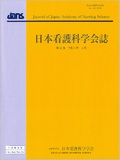Japanese
English
- 販売していません
- Abstract 文献概要
- 参考文献 Reference
要旨
目的:ラットを用いた基礎研究により,カテコラミン製剤の漏出性皮膚傷害に対する確かな看護ケアの確立に向けた基礎的な知見を得ることである.
方法:ラットの背部皮下に実験的な漏出性皮膚傷害を作製し罨法の効果を検討した.
結果:罨法を実施しない対照群では3/6例において観察1日目に発赤を認め,その中の1例は3日目に潰瘍へと変化した.温罨法群では5/6例において1日目に発赤を認め,その発赤は3日目には全例が潰瘍化した.一方で,冷罨法群では発赤,潰瘍などの皮膚傷害は認められなかった.
結論:血管拡張作用を目的に温罨法を実施した動物では,対照群より高い割合で潰瘍を形成したため,これまで推奨されてきた温罨法は皮膚傷害を悪化させる知見が得られた.また,抗炎症作用を目的に冷罨法を実施した動物では,皮膚傷害は認められなかったことから,冷罨法の有効性が示唆された.
Purpose: The present study was to develop an evidence-based nursing procedure for skin lesions induced by subcutaneous injection of catecholamines using an extravasation rat model.
Methods: Skin lesions were induced in rats by subcutaneous injection of catecholamines into the back skin, and then the effects of applying a poultice were observed.
Results: In a control group for which no poultice was applied, flare-up was observed in three rats on the first day, and in one of these rats an ulcer developed on the third day. In a group treated with a hot poultice, flare-up was observed in five rats on the first day, and all of those rats developed ulcers on the third day. On the other hand, no skin lesions occurred in a group treated with a cold poultice.
Conclusion: When extravasation of catecholamines occurs, application of a hot poultice for vasodilation causes deterioration of the skin lesions whereas a cold poultice for suppression of inflammation is effective for prevention of skin lesions.
Copyright © 2021, Japan Academy of Nursing Science. All rights reserved.


